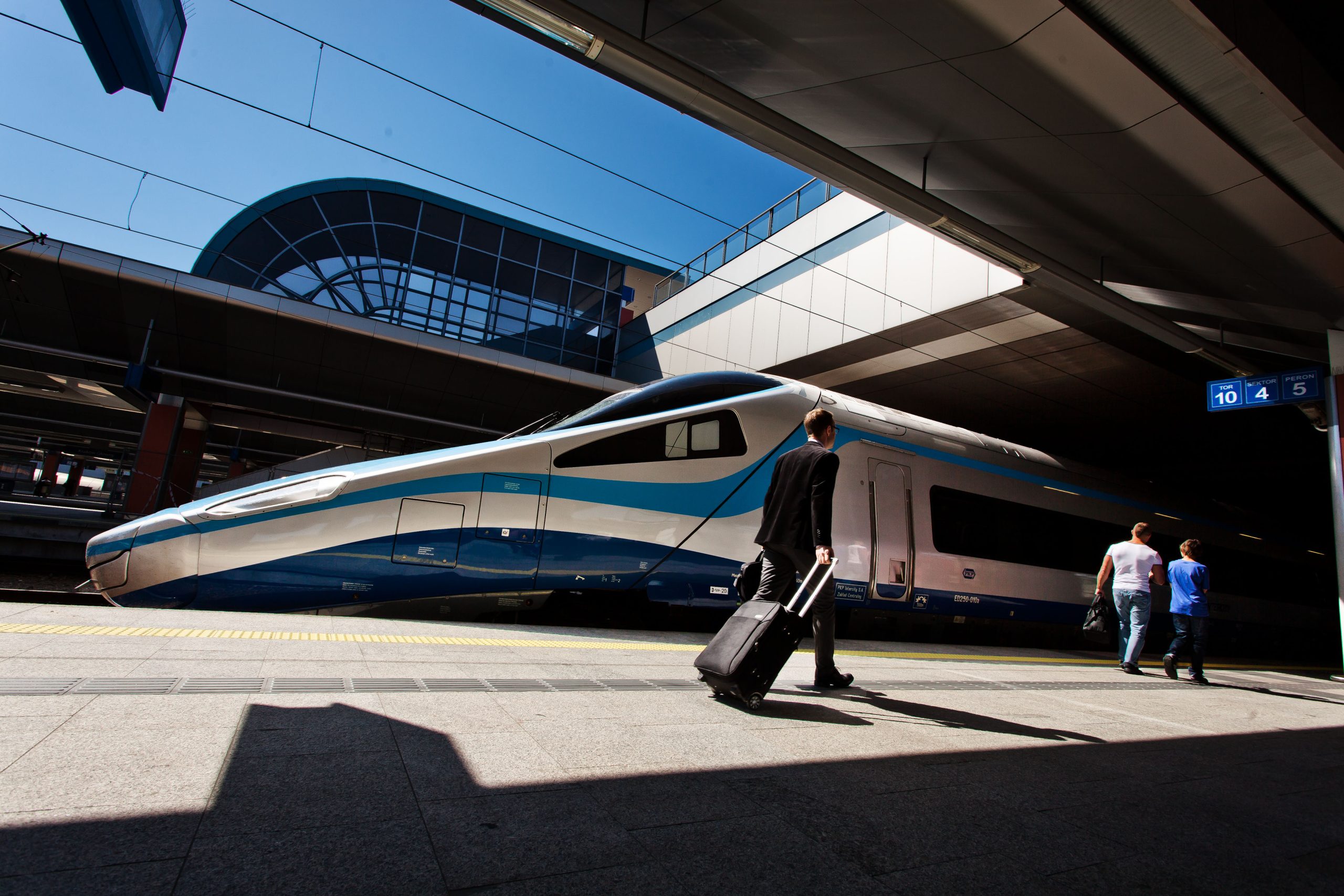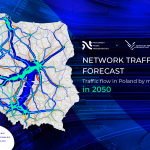 To forecast traffic and plan accordingly, Centralny Port Komunikacyjny (CPK) is using its Passenger Transport Model (PMT), developed in-house by CPK experts which helps implementing its strategic project.
To forecast traffic and plan accordingly, Centralny Port Komunikacyjny (CPK) is using its Passenger Transport Model (PMT), developed in-house by CPK experts which helps implementing its strategic project.
This tool helps in the process of planning and implementing one of the largest transport infrastructure development programmes in the region. The PMT has already gained recognition nationally and internationally for its accuracy. The results of the modelling carried out with the PMT are of interest to rail infrastructure managers from Western Europe in the context of the prospects for the development of the rail market in Poland and the CEE.
CPK’s rail investments involve constructing almost 2,000 km of railway lines, divided into 10 spokes. These new railway lines will primarily serve long-distance trains, including the high-speed railway that will initially reach speeds of 250 km/h, with the possibility of increasing this to 350 km/h in the future. Regional trains and freight trains will also use the new lines on selected routes. Key sections, such as Warsaw – CPK – Łódź, are set to be available as early as 2027, in parallel with the completion of the CPK airport. The new railway infrastructure is due to provide high accessibility to Poland’s capital and the CPK transport hub, with estimates indicating that up to 40% of the people using it will commute by rail.
An advanced planning tool for developing efficient transport systems
The Passenger Transport Model (PMT) is an advanced planning tool that provides the best scenarios for creating an efficient transport system, including cross-border connections, allowing the development of forecasts for the entire country, covering road, rail and air transport. The PMT is capable of estimating the impact of strategic transport investments, such as the construction of high-speed rail, as well as the development of local or regional rail connections. Since its development in December 2020, the PMT has undergone four updates and has been made available to almost 50 entities worldwide. The PMT forecasts have already been used in the development of around 150 studies and projects.
The latest version of the PMT, which is the result of an update related to the plans for the expansion of the railway network and the modernisation of lines under the PKP PLK “Kolej Plus” programme, considers the status of the existing and planned railway network, such as line electrification, number of tracks and permissible speeds, while providing optimistic forecasts for the newly planned and modernised railway lines. The analysis of the data for individual lines shows a moderate growth trend for the railway lines not covered by investments and optimistic forecast results for the newly planned and modernised railway lines, which is due to the increased attractiveness and competitiveness of railway transport compared to other modes of transport.
“Recent years have been full of changes that fundamentally impacted the forecasts for railway traffic. First, the pandemic overturned thinking about transport, and when the situation returned to normal, a war began. Our forecasts, therefore, require changes regarding the determination of passenger flows, cargo types and even the number of inhabitants in the individual countries in our region of Europe. Updates are necessary and allow us to plan subsequent projects so that they are optimal, economically viable and meet future passenger needs,” Michał Pyzik, Transport Modelling & Traffic Forecasting Coordinator at CPK said.
The PMT’s latest forecasts are optimistic about the impact of the significant financial investments planned for railway modernisation in Poland over the next few years. In contrast to the PMT’s projections from a year ago, which estimated that Polish long-distance rail operators would transport a total of 120 million passengers annually in 2050, the latest forecast indicates a 12% increase, with an estimated 134 million passengers being transported in the same year. These promising figures signal a bright future for the railway industry in Poland and suggest that the planned modernisation efforts will help drive growth in the sector.
CPK presents benefits of forecasting in developing sustainable transport infrastructure
Railway infrastructure is critical for enabling mobility, and as transport demands continue to grow then modernising and expanding the railway network becomes essential. The European Investment Bank (EIB) emphasises the importance of filling the gaps in the CEE transport system for the development of the region, bringing significant economic benefits and at the same time enhancing the security of the continent. Moreover, to meet global environmental policy objectives, it is imperative to develop sustainable transport systems that reduce emissions. In this regard, large-scale transport infrastructure development projects must incorporate network traffic forecasting as a fundamental element. By doing so, transport connections can be designed to not only be profitable and efficient in the future but also to stimulate economic growth and provide long-term benefits to the regions they serve.
To forecast traffic and plan accordingly, Centralny Port Komunikacyjny (CPK) is using its own tool, the Passenger Transport Model (PMT), developed in-house by CPK experts. This tool helps in the process of planning and implementing one of the largest transport infrastructure development programs in the region. The PMT has already gained recognition nationally and internationally for its accuracy. The results of the modelling carried out with the PMT are of interest to rail infrastructure managers from Western Europe in the context of the prospects for the development of the rail market in Poland and the CEE.
CPK’s rail investments involve constructing almost 2,000 km of railway lines, divided into 10 spokes. These new railway lines will primarily serve long-distance trains, including the high-speed railway that will initially reach speeds of 250 km/h, with the possibility of increasing this to 350 km/h in the future. Regional trains and freight trains will also use the new lines on selected routes. Key sections, such as Warsaw – CPK – Łódź, are set to be available as early as 2027, in parallel with the completion of the CPK airport. The new railway infrastructure is due to provide high accessibility to Poland’s capital and the CPK transport hub, with estimates indicating that up to 40% of the people using it will commute by rail.
International traffic forecasts
Rail passenger traffic in international passenger transport in CEE significantly affects the overall traffic forecast. Therefore, in order to make it complete and reliable, CPK is cooperating with entities from selected neighbouring countries in this regard. The PMT estimates a growth in international traffic by considering new connections within the HSR V4 project with the Czech Republic, Slovakia and Hungary. In the future, the model will also include data related to cooperation with RB Rail AS, which is implementing the Rail Baltica project to connect Kaunas, Vilnius, Riga, Tallinn, Helsinki and Warsaw. Based on the cooperation agreement signed with Ukrainian Railways in January 2023, CPK will provide PMT to Ukraine to extend the model into this region.
The results of modelling and forecasting using PMT are often used as the basis for applying for EU funding. The increased attractiveness of railways and rising passenger numbers align with the European Union’s priorities to protect the environment and promote low-carbon transport. As the global impact of infrastructure becomes increasingly important, the latest version of the PMT network has also been adapted to be compatible with the General Transit Feed Specification (GTFS).
Several changes to the railways should ensure that this environmentally friendly mode of transport continues to gain supporters. A critical condition for this success is the further development of what transport offers, supported by the liberalization of the railway sector in Poland. The emergence of market competition should contribute to a significant increase in supply and a reduction in ticket prices, resulting in a dynamic increase in rail transport popularity, as seen in other European countries.
Implementing this objective further demonstrates that CPK is not just an airport. As a new transport system, the Polish government aims to create a transfer hub between Warsaw and Łódź, where air, rail and road transport can be integrated.
Share on:






